It is interesting how people position their cars for sale photography. Some are done really well, others not so much so and some are just, well weird. This ’56 Cadillac is one of those, rather unusual ones. That being the case, it warrants a further look. This Sedan De Ville is located in Fort Lauderdale, Florida, and is available, here on craigslist for $3,500.
Technically, Cadillac referred to this four-door hardtop as a Series Sixty-Two Sedan De Ville. The lack of a B pillar gives this behemoth of a car a wide, panoramic side-view. The interesting feature with this Caddy is the landau style roof treatment. I can’t find a reference to such a Cadillac option back in 1956 so I have to believe it’s an add-on. And I have seen every imaginable car under the sun, that ends up in south Florida, with a landau top grafted on – Crown Vic, Toyota Avalon, Buick LeSabre, Hyundai Elantra, etc., it doesn’t matter.
Now, what really has me scratching my head is the assortment of odds and ends positioned around the exterior. Generally, an old car may have a cinderblock under the front end, not positioned in front of the wheel. The other items are confusing too, a homemade wooden frame, an air duct louver and… I’m not sure what else. The seller indicates that “This classic Cadi sat for MANY years unused.” It appears that over the years it has become a repository for stuff, somewhat like a storage locker. And those many years have cooked the paint. The body is straight with no sign of crash damage but the seller indicates that there is some rust as a result of this Sedan De Ville having emigrated from New Jersey. Fortunately, it looks as if this Cadillac’s extensive stainless and chrome trim is all accounted for.
Under the expansive hood is a 285 gross HP, 365 CI V8 engine which looks like it has been silent for a long time. The air cleaner is missing and maybe in the trunk with some other stuff. Note the A/C compressor, it appears to be a later add-on and not the original Frigidaire unit employed by GM cars in the ’50s. It is safe to say this is a non-runner. Gear changes are courtesy of a four-speed Hydramatic, automatic transmission.
Inside is where an interesting collection of objects can be found. I spy a wooden tennis racket press, a pair of motorcycle wheels, and an old Bell System touch-tone console. For good measure, it appears that the glove box door is now on the driver’s side floor. The upholstery looks stained but not ripped – a seat cover maybe? And yes, the A/C is an add-on component as the head-unit with the controls and vents are visible under the dash. It’s hard to get a good look at the rest of the interior through the instrument panel gauge cluster shows, at a distance, to be in clean condition. Unfortunately, the original radio is MIA.
The seller suggests that it would be best to call for more details – a good idea. This poor Sedan De Ville does need to be restored but it looks like it has possibilities – the four-door hardtop body style is a desirable one. The best advice that I can add is to photograph your car, and just your car when you are preparing to sell it. It’s nice that you have other unrelated stuff but no one wants to see it; let’s just stick to the task at hand. Any other suggestions that you can offer?
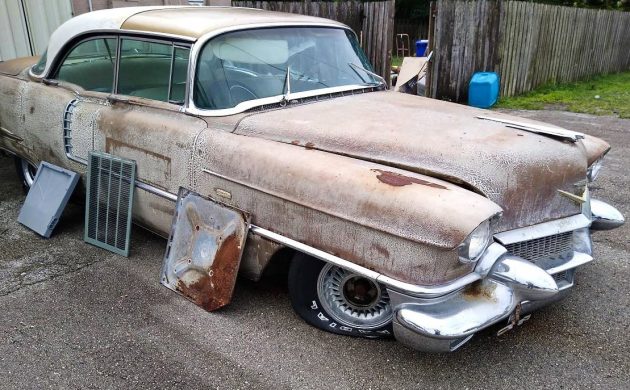
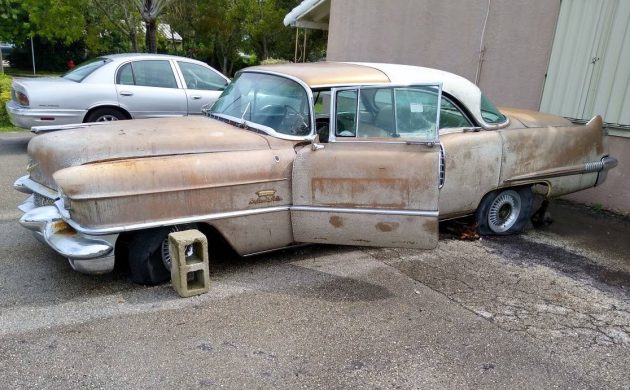
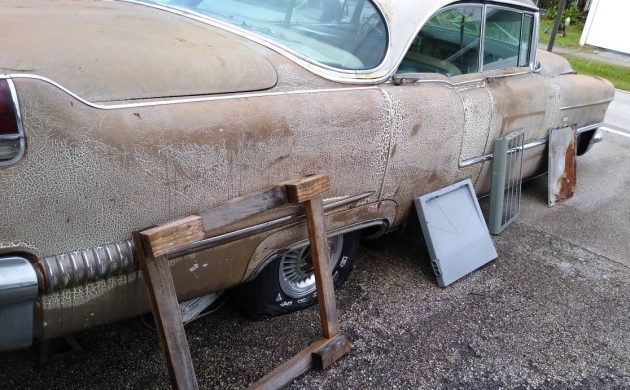
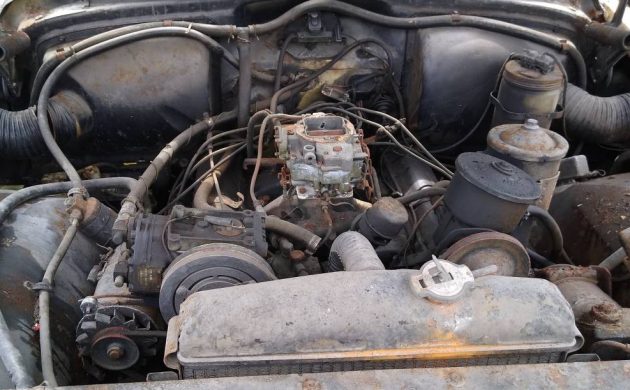
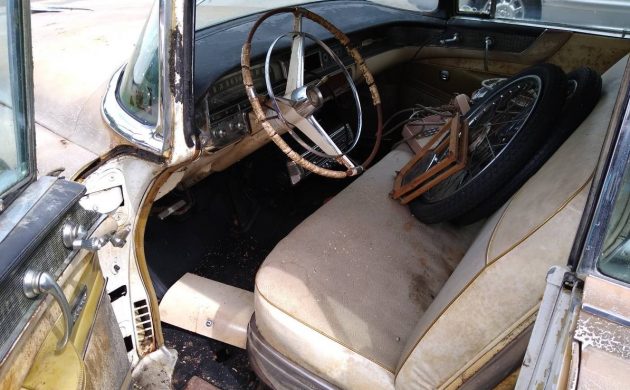
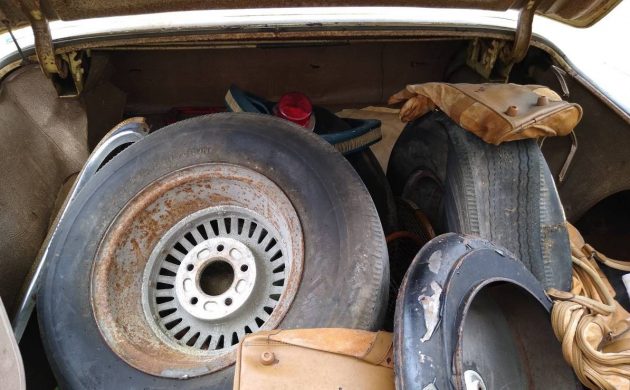
Well, the glass looks intact…
Are those El Dorado wheels?
Sabre spokes, they came on Eldorado’s but were available on all Cadillacs.
Odd that they haven’t been lifted off and out of this Caddy if it’s indeed been sitting in a parking lot that long in Florida. Given the right amount of polish they always spruce up even the most hohum 1950s Cadillac.
Yes. They are quite valuable.
$3.500 valuable?
I sure do not see any other value in this vehicle.
Those turbine wheels, if the center caps are also sitting around, are WORTH THE PRICE OF ADMISSION!
The wheels caught my eye too, I believe they were called Sabre wheels?
There’s a lot to like about this deal, and it’ll get snatched up soon I’d think…
The Sabra wheels are interesting. However very expensive to restore.
A “Parking Lot Find?”
I’ve said it before: “Rust Never Sleeps, and Corrosion Never Goes to Bed,” but now, I say: “Tires ONLY go Phlat on the BOTTOM!
🙃
Smitten again, oh well, I’ll get over it somehow.
Bob
Four door hard tops were popular because they are cooler than a pillared car in the days when ac was so expensive that no one bought it. The govt killed them in the 70s claiming that they were dangerous without the supporting pillar.
I see the lid to the air cleaner. It is a popular addition to any rat rod in fact everything old and cool they are remaking them in fiberglass. No joke. They also came on 56 Packards too. Amazing it is still there.
Note the treatment of the C pillar and the rear window. The C body GM’s all used it from ’54 to ’56 and it is the most pleasing transition design, in my opinion, for this usually unwieldy place.
Maybe not now, but once upon a time, discount stores would pile sales items on a table, mixing sizes and colors, etc., rather than neatly sorting them by size and style. The theory was that shoppers would rummage around through the pile and think they found a real bargain when they discovered something they might like.
This looks like the same tactic. By putting junk in and around this car, it makes the car look like it’s a real find. The same goes with showing “barn finds” with lots of dust and dirt on them.
This car was just sitting outside and there was no junk around it, so hey, let’s put a cinderblock in front of the wheel. Seriously, dude.
I’m thinking, and I could be wrong, at the time that cinder block was positioned in front of the tire, the tires had air. Hence, it couldn’t roll away. Ya think???
Even OLD Cadillacs find their way to Florida. Now it’s the junkyard waiting room! Another……. too bad.
It’s absurd.
Carbuzzard, thats a great observation with the table piled with stuff. I worked for a wise old Jewish autoparts dealer when I got out of high school, and he explained the whole thing. Never forgot it or working for him. I was one the few workers who liked him and he took a liking to me Good stuff, sorry off topic.
Stay safe and good luck . Looks like someone welded the rear doors shut???
Cheers
GPC
If I could get it cheap enough, I would bring it home and put the wheels on my 56 Coupe.
Love it. Sure beats the way over priced Chargers,Comaro,s ,Mustang,s any day of the week. Don,t care much for the pink,but this car restored and used. What a ride it would be and comfortable. I,d definitely have the back ground traced on it. I,d definitely enjoy bringing this back to life. Imagine it looking new and driving around in it and the tales people could have about it. If Mr Capone rode in it and their was 1 picture of him sitting in it. People would want it then. It would raise the price up quick. I just like these old big cars alot and it would take a big garage to be able to work on it.
Al Capone would have been dead about ten years when this car came out. He died the first week of January, 1947. But I get your point.
1955-56 Chrome anodized and 1957-58 Gold anodized Sabre wheels in today’s market typically sell for between $800 for a rough set of 4 needing restoration, to about $2,500 for a set of 4 Chrome ones in very nice original condition. Add about $500 to a set for Gold versions. Add to those prices about $150 to $200 for each center cap, unrestored, but without dents.
I’m familiar with these prices as I was tasked with finding a set of 4 of each type for a wealthy overseas buyer last year [pre-Covid19].
I have a set which i plan to restore someday and put on my 56.
Bob Mck,
In the early 1980s I found a set of the chrome anodized Saber Spoke wheels for my 1955 Fleetwood 60s. They were the only option the car didn’t come with from the factory [it even had the dual 4 carb setup].
My car was painted bright red from the factory, however with the Saber Spoke wheels installed, I felt the car looked too flashy, so I put the original wheels back on, and sold the Saber Spoke wheel set.
I bet your car was spinning! You made someone happy when you sold the Sabra wheels.
Bob,
That car had only about 40,000 miles showing when I sold it, and it was one of the few cars I regretted selling as soon as I watched it drive down our long driveway.
The good news was I sold it to a friend who drove it as an everyday driver for years [his wife drove an original 1954 New Yorker sedan as her everyday car as well], so I serviced it for years afterwards.
He bought the Cadillac and sold his 1953 Packard Patrician because the Packard didn’t have A/C, and the Cadillac did.
Lord help me… I bought it for 2,000. There are 3 more Sabre rims in the trunk…
Please, be sure to post a pic, of your finished product, Cobra.
Will do. Gonna start with the motor… Marvel Mystery oil, after changing 40 year old oil filter…
You really think the oil filter needs changing? LOL!
Cobrajet,
For over 40 years I’ve been “unsticking” motors that sat for decades. One of the things I do is to fill the crankcase with kerosene [just leave the old oil in place for now] and let it sit. This allows the kero to reach the rings from the crankcase side as well as the oil you put in the in the cylinders. Do remember to put the plugs back in place, as the oil will seep thru and run out the plug holes. This process also allows the kero & oil combo to seep into the main & rod bearings!
Then drain it all out and let it drip for a week or 2 before replacing the drain plug. This allows the loosened sludge to slowly drain out
As for Marvel, that’s a great choice. I actually use a 50/50 mix of Marvel and ATF. Once you have the engine running for the first time in years, regardless of your fuel source [the original tank or a 1 gallon can] It’s important to do a “heavy” mix of Marvel oil with the gas, so the valve stems are lubricated while you run it. Make sure you have the engine ready to run for more than a few minutes.
The worst thing you can do is run it for only a few minutes before shutting down, as that can cause the valve stems [they have not yet received adequate lubrication yet] to stick open after you stop the motor. Not getting the stems lubed up, the next time you try to start it, you may find valves stuck open.
When you replace the cannister filter, take a minute to carefully wipe the filter housing and remove the sludge buildup at the bottom. Also, once the filter is in place, slowly add new oil, topping it up as the oil goes into the filter itself.
I don’t remember if the Cadillac oil filter is a bypass type that takes the filtered oil & dumps it back into the sump, so check the dipstick to make sure the oil level doesn’t get too high from the oil going right back into the sump. I don’t think it’s a bypass type, but if anyone reading this knows for sure, please add your comment.
I had a 1948 Packard Limo with the 356 9-main bearing straight 8 engine that was parked in 1950. I bought it in 1980, & realized the engine was stuck from sitting for 30 years. After doing the above work it started right up, and a week later after bleeding the brakes, using a 5 gallon outboard boat motor fuel tank in the trunk, rebuilding the fuel pump, & adding water/anti-freeze mix, I drove it to a Packard club meet in York, PA, & back to the DC area without a problem. And did I mention it was near 100f temp that day?
“Nutt’n like a Packard!”
Bill, your stories always fascinate. One caveat that I have started to dismiss in recent years is “what put the car down to begin with?” As with any machine, unless you know the whole history and why it was idled after only two years my “caveat” mind would tell me not to risk any long distance drive. I’d break the motor down for inspection, as well as the electrical, instrumentation, suspension, steering and brakes. But what fun is there in that when you’ve got the thing purring like a kitten after 30 years, right? Has there been a moment in your restoration business when you decided not to let caveat emptor no longer rule your decisions?
Little_Cars,
Glad you caught that point where it had been put into storage after only 2 years!
That story alone is fascinating. When I bought it, the limo had been repainted into a “Diamond Cab” yellow and black design. The guy had bought the limo very cheaply at a GSA auction, as it had been a US government vehicle. So he was going to run a taxi service with it. As I recall it only had about 25,000 miles showing, but had sat outside all those years.
Problem was, at that time the DC Taxi Office only allowed 4-door 6 passenger sedans, and long wheelbase sedans & limousines were excluded for some strange reason. So he simply parked the limo in back of his machine shop [they rebuilt big printing presses] and there it sat until I bought it and 2 other 1950 Packards.
After he sold me the 3 cars, he took me to a garage and showed me a 14,000 mile 1956 Packard Executive 2-door hardtop, in Packard’s “Scottish Heather” [a gorgeous bright red with a slight pink color]. The car was near perfect except for a big nasty dent in the trunk lid.
I wanted that car soooooo badly, but after buying the other 3 cars I could not afford it. A friend of mine in the club ended up with it.
As for your other questions/comments, I could tell from the condition of the various parts, that this car had never been in livery use. The interior had been covered in vinyl to protect the original interior that after uncovering, was near perfect. So I didn’t think a teardown was warranted. [And we ARE talking about a Packard 356 9-main bearing Super Eight motor.] Of course the motor was so smooth at idle, it was no problem in balancing a nickel on it’s edge, on the cylinder head, at idle.
That said, if we had a car come in for restoration, unless it was a recent engine rebuild, or a very low mileage engine [or trans], it was torn down for inspection. Almost all ended up being rebuilt.
Up into the 1990s it was common to find ultra low mileage “old cars” languishing in garages all over the Washington, DC area. Many of them, after unsticking the engine, continued to run for decades.
But those stories are for another day.
One question Bill if you please. By “heavy” mix do you mean like 25-1 or 50-1?
On and On,
I don’t remember what the instructions were on the side of the can, but I had doubled the amount of Marvel per gallon. This did result in a light blue cloud, but to me that meant the valve stems were getting lubricated.
I see. Thank you Bill. I’ve used 50-1 outboard mix to start dry engines till they smoke for awhile to lube everything and wet seals and guides. No harm is done, a new set of plugs and your good to go……..
Bill Thank you for the tips. When I was a kid, 70’s, I used to help the neighborhood motorheads work on their street rods. After 40 years in the construction field I forgot a lot of what they taught me. One thing I did remember was an old oil filter disintegrating and going all up in the motor cause it wasn’t changed. Will definitely take your advice.
Cobrajet,
Back in the early 1950s a guy “invented” a way to use rolls of toilet paper as a cartridge to replace oil filters! I know of 2 cars who used these, both had strange thick sludge in the pans, and half way disintegrated oil “filters”.
Bill, how much kero, old oil, combo are you talking about if it’s gonna come out the plugs? A gallon? And, at the sake of being a pain… When you say, “As for Marvel, that’s a great choice. I actually use a 50/50 mix of Marvel and ATF. ” Is that what you are suggesting as a fuel mix, or for another application?
Cobrajet,
No, not the fuel mix. The 50/50 mix of ATF and Marvel is for injecting into the combustion side of the cylinders.
Because each motor has a different crankcase volume, and you want to fill it all the way [as much as possible], the amount required will vary. Most engines will probably fill up to the dipstick hole and pour out there.
Ideally you want to reach the bottom of the cylinders, so the hydroscopic action of the oil/kero will reach the rings of most of the cylinders.
And as for the mix coming out of the spark plug holes, it won’t come pouring out, but on a V-type motor it will gradually seep out as the crankcase mix comes up past the rings. On a straight line motor this is not a problem.